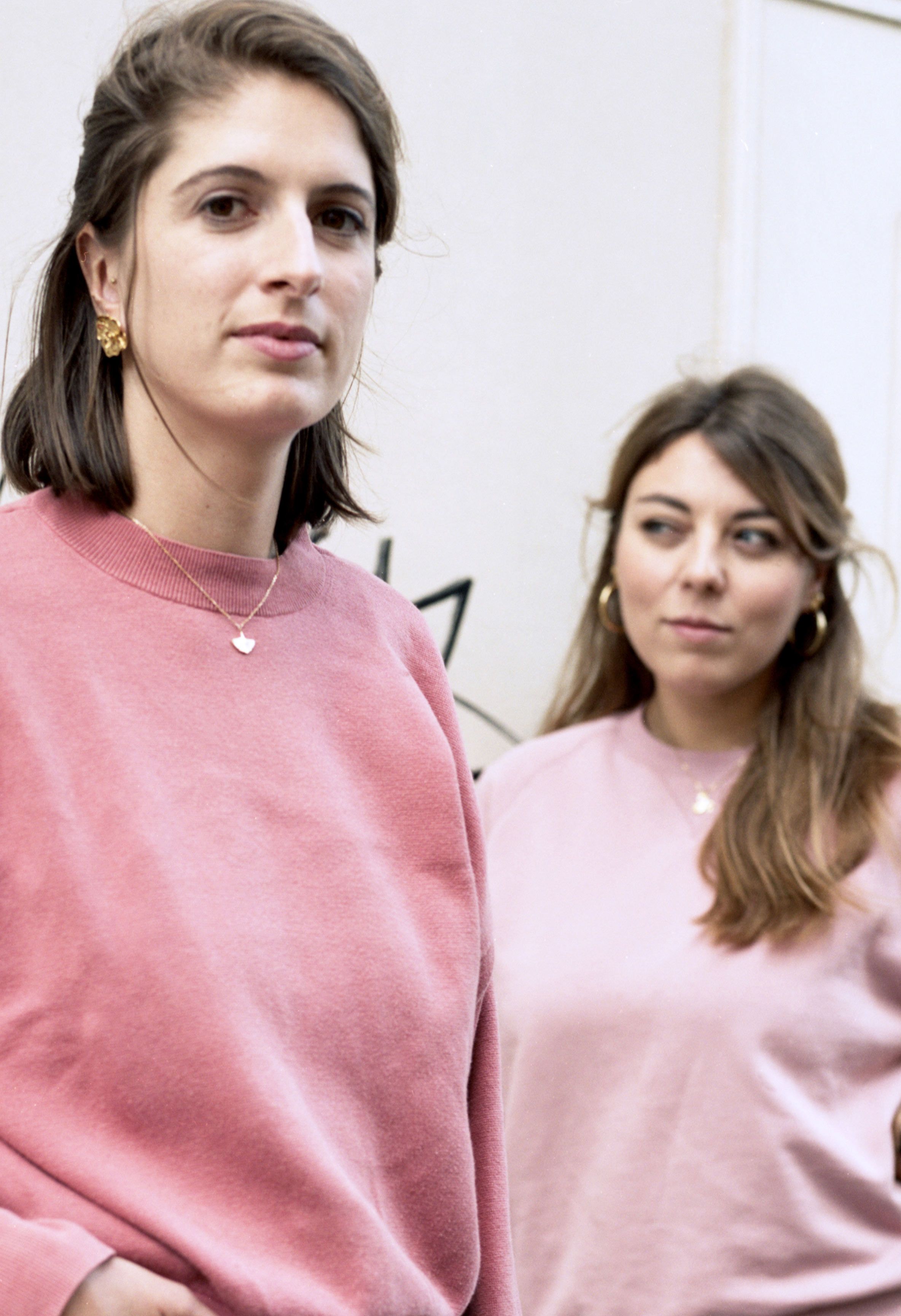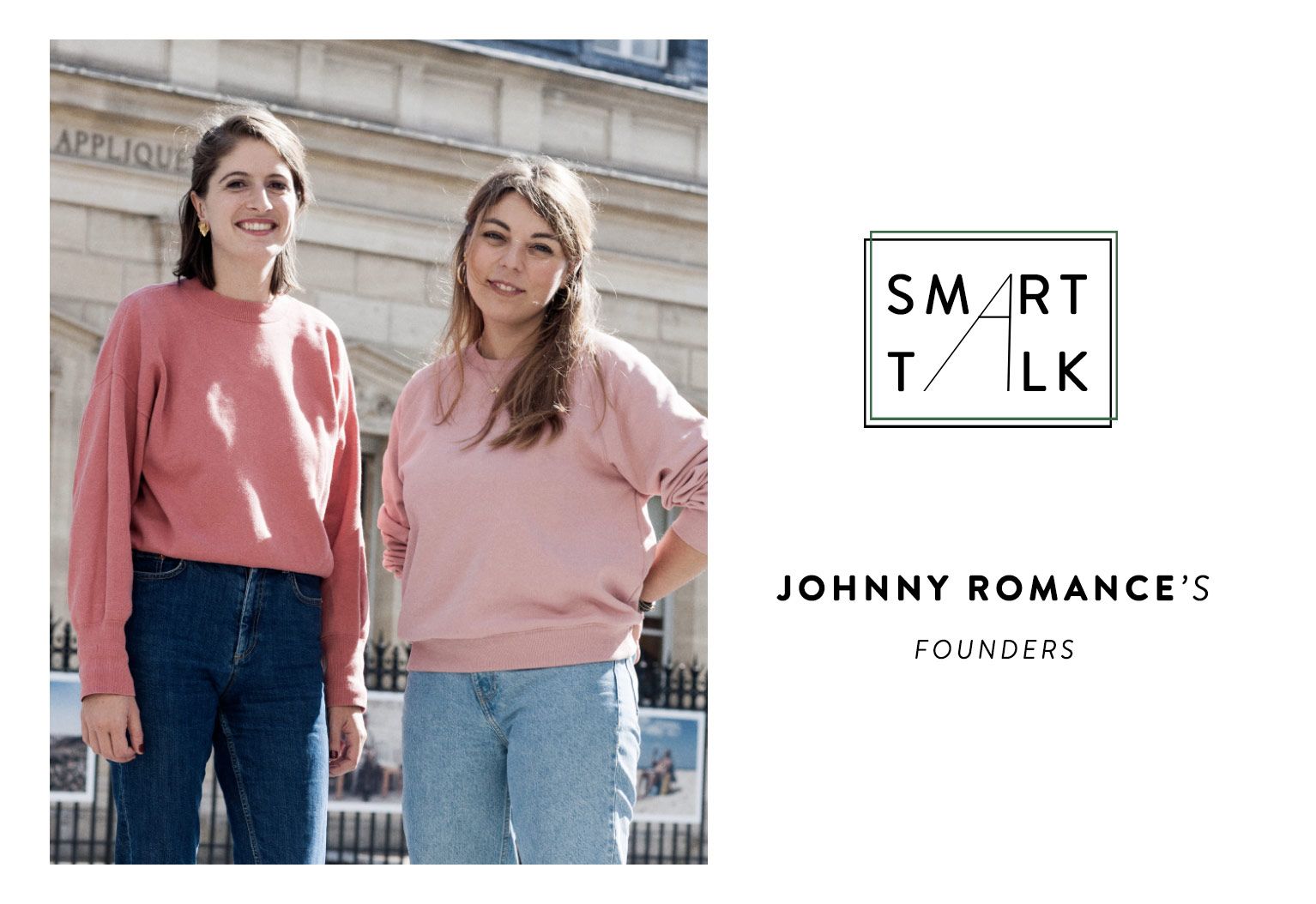Manon
: Hi, my name’s Manon, I founded Johnny Romance with Laura. We met at college and both studied applied arts and design at Atelier Chardon Savard.
Laura
: I’m Laura, I have the same background as Manon. We went to school together until we started internships. I studied textile design and photography before embarking on an accelerated business course as part of the adie creajeune were we founded Johnny Romance as our final year project.
L
: Me, yes. I’ve wanted to create my own clothing brand since I was little. I was always drawn to fashion and illustration. It always seemed like a logical step for me.
M
: My desire to start creating clothing came during my studies. At the start, I wanted to be a set designer, that’s why I decided to study applied arts. I quickly realised that it wasn’t for me. As textiles has always interested me, I decided to enrol in fashion school. After that, it was really my internships that influenced me. I completed a design internship in a small atelier called Raphaelle H’limi. Captivated by the creative energy and having the opportunity to really experience all sides of the running of the atelier inspired me. But honestly, working in a small scale business proved it was possible to create your own business from scratch.
L
: Yes, I agree. I also worked in a small knitwear company called Monsieur Lacenaire. Completing all tasks in the same studio – everything from pattern cutting to customer service, allowed me to see the complexity of being a designer, it’s not just about sketching.
M
: We just quit our jobs to work on Johnny Romance at 100%. It’s a big change.
L: Yes, we are going to apen a boutique on December in Paris.
M
: Personally, cross-stitch has always been a part of my life. My grandmother and my mother used to do it all the time and it was always a way to keep my hands busy when I was growing up. It’s something I’ve known since childhood. With Johnny Romance, we wanted to show that cross-stitch can be a modern medium. The texture and style of cross-stitch is also very visually interesting, too.
L
: There was also this idea of combining traditional savoir-faire with ready to wear.
M : For our final major project at university, we created a runway show that showcased big, tattooed, bearded men walking down the catwalk in leather jackets, combat boots and floral dresses. The name Johnny Romance is an expression of that masculinity and femininity – Johnny being quite laddish and Romance offering a quintessential floral aspect, embroidered in cross-stitch across the heart. The name is also a reference to the kitsch aspect of the brand. It highlights the feminine part in every man - because Johnny Romance was a menswear brand to start out with.


L : We realised that our pieces were being purchased by women as well as men and we wanted to address this growing gender neutrality trend. It hasn’t changed the way we work or the styles we use, we just include more sizes. We have started creating XS, something we didn’t do before. It has definitely changed our artistic direction though. Being a unisex brand gives us more freedom with colours and patterns.
M : It’s a question of taste. We find that masculine cuts work well for women, too. It also corresponds better with our brand image. We didn’t particularly want to launch a range of V-necks and boat neck designs. Classic menswear silhouettes suit us best and, a large proportion of our customers are still men.
M
: Throughout the season, we will go and collect flowers that bloom either in summer or winter and represent a certain place or time of year in particular. For the AW19 collection, we captured the flora of the mountains, with lots of edelweiss and berries. For next summer, we’re creating a Riviera-inspired collection - so look out for jasmine, daisies and olive trees.
L
: We try to choose them based on their names and what they signify. For example: flowers that have names also used as first names like Iris or Capucine, tend to work well. But, when we find a seasonal flower that is visually pleasing and then find out it has a symbolic meaning, we’re always chuffed.
M : Yes, that’s right, it’s also our brand logo. It’s timeless. We feature it each season in new colour ways.
M : This winter is the first season where we have featured patterns other than flowers, but always using cross-stitch with a bucolic spirit to each design. This season we showcased mountains, next summer we’ll explore the coastline.


L
: Our travels, events or adventures… We also follow lots of illustrators that work with floral themes like Inès Longevial or Marie-Laure Cruschi.
M
: We also draw inspiration from botanical books and old cross-stitch magazines – given to me by my family.
M : OEKO TEX is a certification body that accredits factories that don’t use chemical products in the process of manufacturing clothing, whether that’s cultivating the natural fibres in the field or during the transformation of the product into a textile. Clothing that is certified OEKO TEX is guaranteed against chemical pollution for both mankind and the planet.
M : Yes, we also respect the conventions of GOTS (Global Organic Textile Standard) and Fair Wear. GOTS certification ensures the use of natural fibres and production methods that reduce environmental impact. This label evaluates each stage of the production process up to commercialisation – including everything from shipping, manufacture, packing and labelling. Fair Ware focuses more on the ethical implications of production and covers safe working conditions.
L : Yes, it’s always been important to respond to these standards. Because we manufacture our products in France, but also in Bangladesh, we’ve always had quality at the heart of our production process – this means ensuring the people we collaborate with respect fundamental ethical rules, in particular, safe working conditions, as we know Bangladesh has a bad reputation in particular. The next step is to bring that production process back to Europe. In our next collection, certain pieces will be manufactured in Portugal.
M : It was the factory in France where we embroider the pieces that introduced us to our partner in Bangladesh. It is certified by ethical and environmental standards agencies and respects the values we uphold.
L : We regularly visit places like Biarritz and Oléron as our families live in the South West, so we heard about the factory by word of mouth. Each design is machine-made. After a bit of training on embroidering techniques, we succeeded in getting the right result pretty quickly.
M : We showed them the techniques we wanted and presented them with pixelated sketches so they could create the right structure for the cross-stitch. Afterward, we collaborated with them to create the work on the machines.
L : We started a crowd funding campaign with KissKissBankBank in 2017 to help launch our first pop-up store. L’Exception was one of our mentors during this project and one of the first stores to support us.
M : We’ll be giving 100% to the brand and our collections. We want to be able to offer a full collection and some accessories, too. We’d also like to find an office space, but the ultimate goal is to open a boutique.
M
: My first trip to London and discovering flea markets.
L
: L: The fashion magazines my mother used to bring back from all over the world– she was an air hostess.
M & L : Yinde by BCUC.
M & L : Laurence Anyways by Xavier Dolan.
M & L : Flowers.
M
: Le Caminito, a French cuisine restaurant that we love in the 13th arrondissement.
L
: The Forney library and also La maison Deyrolle



